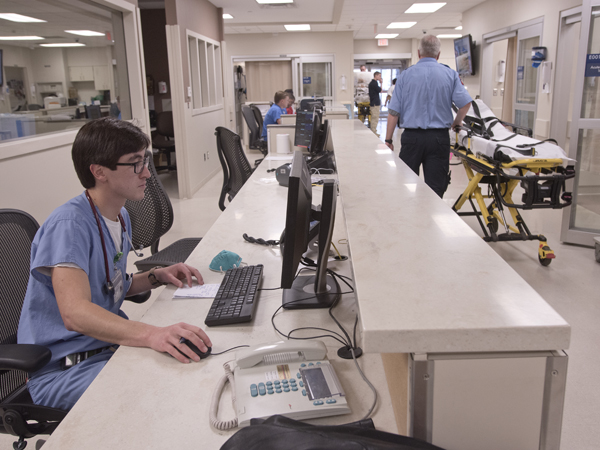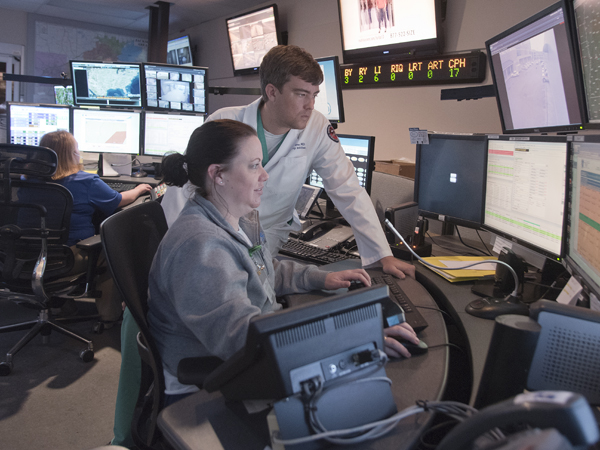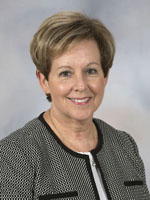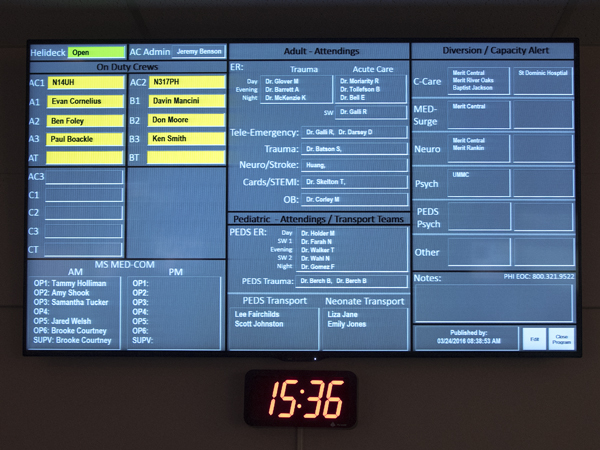‘Capacity alert’ plan coordinates best use of hospital beds

It's become almost a new norm: Unprecedented high volumes of patients are keeping the University of Mississippi Medical Center hospitals at or near capacity, sometimes pushing demand for beds, staffing and other medical resources beyond what's available.
Administrators have a plan to manage the transfer of patients from other hospital emergency departments to UMMC's Emergency Department and the transfer of inpatients from other facilities to the Medical Center's 406 critical care and medical-surgical beds. When beds are full or expected to be full given scheduled admissions and transfers, a “capacity alert” will be declared.
Patients waiting for a bed are considered boarded, meaning they're being temporarily cared for in another hospital location rather than a regular patient room.
When a capacity alert is declared, an email message will be distributed to multiple departments, including providers, leadership and MedCom. Newly created Medical Control Officers, or MCOs, will lead the decision-making on transfers requested by another hospital's ED or inpatient physicians.
The Medical Center's ED physician on duty will act as an MCO, coordinating with MedCom requests for emergency transfers. An MCO appointed in collaboration between administrators and medical staff leadership will evaluate requests from other hospitals to place inpatients in the adult hospitals or ICUs.
“We want to accommodate all patients who need the level of care provided by this facility that might not be provided anywhere else,” said Trish McDaniel, the adult hospitals' chief operating officer. “When we're on capacity alert, we've either met or are fast approaching our ability to do that.”

A capacity alert “is a protective mechanism to ensure patients here are able to be cared for at the highest level, whether it's a patient in the ED or ones that we know are coming in,” said Dr. Damon Darsey, assistant professor of emergency medicine and medical director for the Mississippi Center for Emergency Services.
McDaniel said MCOs will have frank conversations with referring providers. “They will talk about the circumstances of the transfer to ensure we have the people and resources to handle it while under capacity alert.”

“If a transfer from another hospital's emergency department is for treatment that only we can provide, then all efforts will be made to get that transfer here,” she said. “We may have to do some juggling, but we also want to avoid having to postpone a scheduled admission.”
A capacity alert will be triggered “when we have at least four or more boarded patients in the ED,” said Dr. Alan Jones, professor and chair of the Department of Emergency Medicine. “That means we in the ED are on the highest capacity alert status that we can be on.”
In the ED, alert status is defined by colors. Green means there are no boarded patients, only a few people in the ED waiting room, and open treatment rooms. Yellow means there are still patients in the ED waiting room and all treatment rooms are full, but hospital beds are available, Jones said.
A red status is when hospital beds aren't available, the ED waiting room is full, admitted patients are being boarded, and treatment rooms are backing up, Jones said.

James Campbell, a nurse practitioner in the adult ED, said caregivers pull together when the patient flow approaches or calls for a capacity alert. “We float around and take the next patient, wherever we are,” Campbell said. “We are extremely flexible.”
Campbell recalled a recent day when more than two dozen people were boarding in the ED. He and nurse practitioner Brian Overstreet were seeing patients in areas of the ED opened up to accommodate patients during high capacity. “We handled it,” he said. “We did what we needed to do.”

“Our day-to-day operations of moving patients though the ED are very dependent upon hospital capacity, and it's important to be able to plan for the incoming patients,” said Rebecca Benson, a nurse manager in the ED. “Our system of care has been challenged recently with capacity restraints, but I think we as an organization have a good understanding of our unique resources.”
Not just patients in the ED waiting for a bed, but those who have undergone surgery or a short-stay procedure or who are in either the post anesthesia care unit or cardiovascular holding contribute to the need to call a capacity alert, McDaniel said. In the case of transfer requests for transplant patients, stroke or cardiac patients, she said, “that's why the physician-to-physician conversation is so critical. They will understand the medical implications.”

If another hospital asks to transfer a patient to the Medical Center with needs that can be met elsewhere—for example, high blood glucose—that request might be denied. “We need to be careful about the patients that we allow to be transferred here,” Jones said.
Incoming ambulances will not be turned away, nor will patients who have their own transportation to the ED. If a Medical Center physician seeing a patient in a clinic “believes they need to be admitted as an emergency, we will make every effort to accommodate them,” McDaniel said.
It's important to note that even when the Medical Center is under a capacity alert, there always must be a plan for the unexpected, Darsey said. “There's always the unknown, like a bus crash or multiple shootings. How can you make room for even more?”
“We recognize that when you reach or are at capacity, people have to work harder and smarter,” McDaniel said. “It puts a strain on the hospital. We appreciate them rising to the occasion and meeting the requirements every day.”
Jones said it's not easy to predict when a capacity alert will be needed. “Some providers want to use UMMC. They believe we offer good medical care, and they call us first,” he said. “We are their transfer care of preference.”
“Utilizing capacity alerts triggers and continues all our efforts around improving patient flow and reducing length of stay,” McDaniel said. “They are important initiatives, because the Medical Center provides so many unique services to Mississippi residents.”


